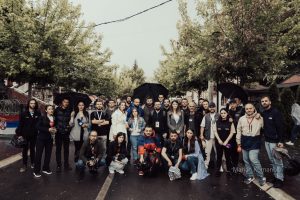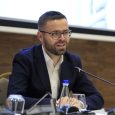In late May and early June, dozens of journalists, camera operators and photographers were the target of some of the worst physical and verbal attacks in recent years in Kosovo. With the return of violent protests in the north of the country, journalists found themselves between law enforcement and the protesters. KFOR soldiers from NATO weren’t the only group to face attacks from protesters. Journalists did too.
What exactly happened to journalists during violence in the north?
Before 7:00 a.m. on May 29, nine television stations with national coverage in Kosovo and many other news agencies sent teams of two or three people to Zvečan, Leposavić and Zubin Potok, the three Serb-majority municipalities where local Serbs started protesting on May 26. They were protesting against the newly elected Albanian mayors’ attempts to install themselves in the local municipality buildings. The mayors came to office in April local elections which had 3% voter turnout due to a Serb boycott.
The day passed peacefully in Leposavić and Zubin Potok, but in Zvečan the atmosphere was hostile and dangerous. In the ensuing violence 30 KFOR soldiers were injured as well as numerous Serb protestors.
Together with colleagues from Euronews Albania and Top Channel, I arrived in Zvečan at noon on May 29 to report on the tense situation. We parked our car, which had Albanian license plates, behind the municipality building. We did this assuming that the 50 or so KFOR soldiers 20 meters away would ensure that our car was not vandalized by the 10 young masked Serbs who were hurling insults at us from the second floor of another building.
However, within five minutes we were alarmed by video footage from other colleagues that showed that our car had been vandalized and its license plates had been ripped off. When we moved the car somewhere safer, bottles flew over our heads along with threats and calls to leave Zvečan. These threats came from masked people standing in front of the municipality building surrounded by KFOR. Dozens of journalists felt this hostile atmosphere. Other cars were sprayed with nationalist symbols, such as the four “Cs” meaning “Only Unity Saves the Serbs” and the symbol of Russian aggression against Ukraine, “Z.”
In the afternoon, when KFOR decided to intervene and disperse the protesters, journalists found themselves caught between the two sides. While the KFOR soldiers had equipment to protect themselves from stones and Molotov cocktails being thrown their way, the journalists had no protective equipment, not even simple tear gas masks.
A cafe between the protesters and law enforcement became a refuge for journalists to escape the violence that continued for almost an hour. Over 40 journalists took shelter inside it, most of us Albanians, but also a number of Serbs. As the situation calmed down, the Serb journalists left and suggested we leave with them. However, for our safety, most of us decided to stay. From the cafe’s windows we could see masked men continuing to attack KFOR.
We went out a number times to ask KFOR to create a safe corridor for the teams to leave. They disregarded our safety and told us that we should use the road where the masked protesters were waiting.
After three hours inside the cafe, the owner accompanied me and about 30 other journalists to our cars. The walk was short, around five minutes, but the insults and curses from the people we passed made it uncomfortable.
One media worker entered the municipality building with the police escort and was trapped there until midnight, only to find their car vandalized in the town center the next day.
The intimidating atmosphere continued the next day on May 30, when the Kosovo Journalists Association (AJK) recorded eight attacks on media workers. After a few days the protests calmed down and attacks became rarer, but the environment for journalists remains unsafe.


